
Family Apidae > Genus Xylocopa

Xylocopa virginica visiting Vaccinium.
Xylocopa
Large Carpenter Bees
In Minnesota, there is one described species within the genus Xylocopa —Xylocopa virginica. It is not known whether there are established populations of Xylocopa virginica from a range expansion into Minnesota or if nests in wood were transported into the state by human means. One female was collected in 1969 and a second in 2016 during surveys. In 2025, a male was photographed in Ramsey County. In the past fifteen years, Xylocopa virginica has expanded its eastern United States range northward into southern Ontario and northwest into Wisconsin. This large (bumble bee-like) carpenter bee nests in aboveground cavities in wood excavated by females. Females often reuse or expand existing nests in lieu of excavating new cavities.
Xylocopa virginica ranges from 17-23 mm (0.67-0.91") in length. It has a broad black head, dark wings, and yellow or amber hairs on the thorax and first abdominal segment (tergite). The rest of the abdomen is black, shiny, and relatively hairless. Males have a cream or light yellow clypeus and bulging gray-green compound eyes. Females have dark compound eyes and collect pollen on hairs on the hind leg tibia and basitarsus. This bee species has a very long forewing marginal cell and a hind wind jugal lobe.
Male and female carpenter bees overwinter as adults and emerge in spring. Males typically emerge prior to females, establish a territory near the emergence site, then wait for females to emerge. After mating, females either reuse an existing cavity in wood or excavate a new cavity. For new nest excavations, they initially create a hole perpendicular to the wood grain, then excavate a curved burrow to run parallel with the wood grain. Wood structures such as sheds or fence posts are common places for females to establish nests, particularly in untreated wood. Tree stumps or standing dead trees are common sites in natural habitats.
Xylocopa virginica can have either solitary or social nests. In social nests, the primary egg-laying female performs much of the foraging and brood-provisioning tasks. Non-reproductive females guard the nest. Spring nest foundresses often die by summer so another reproductive female assumes the egg-laying role.


wing
position
on flowers
1
no. species
in mn

size range
Phenology

Note: Projected Minnesota phenology - modeled after Wisconsin phenology.
Genus/Species Characteristics

male
Males with white or cream clypeus and bulging gray-green compound eyes.

female
Broad black head, dark wings, dark yellow or amber hairs on thorax and first tergite (T1); shiny black abdomen.

female
Females with dark eyes and pollen-collecting hairs on the hind leg tibia and basitarsus.

female
Broad black head and dark spot on thorax.
Distribution

Minnesota
Portman et al (2023)

Regional Map
Xylocopa virginica subsp. virginica in GBIF Secretariat (2023). GBIF Backbone Taxonomy. Checklist dataset https://doi.org/10.15468/39omei accessed via GBIF.org on 2025-06-25.


Explore More Apidae Genera
Explore Bee Families

Apidae
15 genera, 133 species
Bumble bees Bombus
Longhorn bees
Epimelissodes, Eucera, Melissodes
Carpenter bees
Ceratina, Xylocopa
Honey bees Apis
Digger bees Anthophora
Cuckoo bees Brachymelecta, Epeolus, Holcopasites, Nomada, Neolarra, Triepeolus
Squash bees Xenoglossa

2 genera, 39 species
Halictidae
10 genera, 133 species
Metallic green sweat bees
Agapostemon, Augochlora, Augochlorella, Augochloropsis
Large sweat bees
Dieunomia, Nomia
Short-faced bees Dufourea
Sweat bees Halictus
Small sweat bees Lasioglossum
Cuckoo (blood) bees Sphecodes
Megachilidae
14 genera, 86 species
Resin and pebble bees Anthidiellum, Dianthidium, Heriades, Paranthidium
Carder bees Anthidium, Pseudoanthidium
Mock orange bees Chelostoma
Mason bees Osmia, Hoplitis
Leafcutter bees Megachile
Sharp-tailed cuckoo bees Coelioxys
Dark cuckoo bees Stelis

Citations and Further Reading
Droege, S., Shumar, S., & Maffei, C. (2024). The Very Handy Bee Manual (2.0). Zenodo. https://doi.org/10.5281/zenodo.12812755
Portman, Z. M., Gardner, J., Lane, I. G., Gerjets, N., Petersen, J. D., Ascher, J. S., ... & Cariveau, D. P. (2023). A checklist of the bees (Hymenoptera: Apoidea) of Minnesota. Zootaxa, 5304(1), 1-95.
Tripodi, A. D., & Szalanski, A. L. (2011). Further Range Extension of Xylocopa micans Lepeletier (Hymenoptera: Apidae). Journal of the Kansas Entomological Society, 84(2), 163-164.
Wilson, J. S., & Messinger Carril, O. J. (2016). The bees in your backyard: a guide to North America's bees. Princeton University Press.
Page Photography Credits
Heather Holm
Steve Mlodinow CC BY-NC 4.0 (Brachymelecta)
Michelle Orcutt CC-BY-NC 4.0 (Epimelissodes female)



















